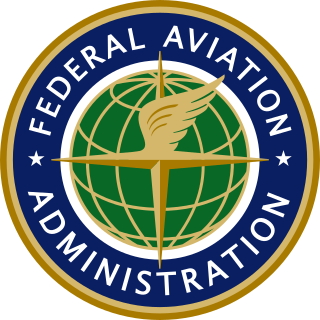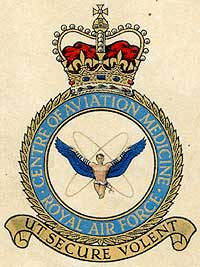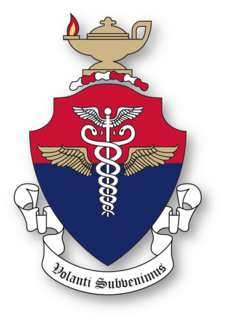
The Federal Aviation Administration (FAA) is the largest transportation agency of the U.S. government and regulates all aspects of civil aviation in the country as well as over surrounding international waters. Its powers include air traffic management, certification of personnel and aircraft, setting standards for airports, and protection of U.S. assets during the launch or re-entry of commercial space vehicles. Powers over neighboring international waters were delegated to the FAA by authority of the International Civil Aviation Organization.

A flight surgeon is a military medical officer practicing in the clinical field of aviation medicine. Although the term "flight surgery" is considered improper by purists, it may occasionally be encountered.

Aviation safety is the study and practice of managing risks in aviation. This includes preventing aviation accidents and incidents through research, educating air travel personnel, passengers and the general public, as well as the design of aircraft and aviation infrastructure. The aviation industry is subject to significant regulation and oversight.
To assume a brace position or crash position is an instruction that can be given to prepare for a crash, such as on an aircraft; the instruction to "Brace for impact!" or "Brace! Brace!" is often given if the aircraft must make an emergency landing on land or water. There are many different ways to adopt the brace position, with many countries adopting their own version based on research performed by their own aviation authority or that of other countries. The most common in passenger airliners being the forward-facing seat version, in which the person bracing places their head against or as close as possible to the surface it is likely to strike, placing their feet firmly on the floor, and their hands either on their head or the seat in front.

Aviation medicine, also called flight medicine or aerospace medicine, is a preventive or occupational medicine in which the patients/subjects are pilots, aircrews, or astronauts. The specialty strives to treat or prevent conditions to which aircrews are particularly susceptible, applies medical knowledge to the human factors in aviation and is thus a critical component of aviation safety. A military practitioner of aviation medicine may be called a flight surgeon and a civilian practitioner is an aviation medical examiner. One of the biggest differences between the military and civilian flight doctors is the military flight surgeon's requirement to log flight hours.
In Europe, the United States, and other countries, an aviation medical examiner or aero-medical examiner (AME) is a physician designated by the local aviation authority and given the authority to perform flight physical examinations and issue aviation medical certificates. AMEs are practitioners of aviation medicine, although most are also qualified in other medical specialties.

Brooks Air Force Base was a United States Air Force facility, located in San Antonio, Texas. It was closed on September 30, 2011.

Human senses are not naturally geared for the inflight environment. Pilots may experience disorientation and loss of perspective, creating illusions that range from false horizons to sensory conflict with instrument readings or the misjudging of altitude over water.
The Wendell H. Ford Aviation Investment and Reform Act for the 21st Century is a United States federal law, signed on 5 April 2000, seeking to improve airline safety. It is popularly called "AIR 21," and is also known as Public Law 106-181.

The 311th Human Systems Wing is an inactive wing of the United States Air Force. It was stationed at Brooks City-Base in San Antonio, Texas.
In the United States, there are three classes of medical certifications for pilots; such certificates are required to legally exercise the privileges of a Pilot exercising the privileges of either a Private, Commercial or Airline Transport Pilot license. Medical Certificates are not needed for Glider, Balloon, Recreational or Sport Pilot certifications. Each certificate must be issued by a doctor approved by the Federal Aviation Administration to a person of stable physical and mental health.

The Aerospace Medical Association (AsMA) is the largest professional organization in the fields of aviation, space, and environmental medicine. The AsMA membership includes aerospace and hyperbaric medical specialists, scientists, flight nurses, physiologists, and researchers from all over the world.

Fatigue is a major safety concern in many fields, but especially in transportation, because fatigue can result in disastrous accidents. Fatigue is considered an internal precondition for unsafe acts because it negatively affects the human operator's internal state. Research has generally focused on pilots, truck drivers, and shift workers.

The RAF Centre of Aviation Medicine is a medical organisation run by the Royal Air Force and based at RAF Henlow in Bedfordshire. It is the main organisation conducting aviation medicine research in the UK.
Mike Monroney Aeronautical Center is a regional office of the United States Federal Aviation Administration on the grounds of Will Rogers Airport in Oklahoma City. With around 7,500 direct federal employees, the Aeronautical Center is one of the Department of Transportation's largest facilities outside the Washington, DC area, and one of the 10 largest employers in the Oklahoma City metropolitan area. It is named for Senator Mike Monroney of Oklahoma, who wrote and sponsored the Federal Aviation Act of 1958.

Air medical services is a comprehensive term covering the use of air transportation, aeroplane or helicopter, to move patients to and from healthcare facilities and accident scenes. Personnel provide comprehensive prehospital and emergency and critical care to all types of patients during aeromedical evacuation or rescue operations aboard helicopter and propeller aircraft or jet aircraft.
The Academy of Technical Training is a privately owned institution which provides training programs in aviation security and safety, air traffic control, and management of aircraft accidents. The curriculum and courses are accredited and certified by the General Civil Aviation Authority.

The United States Air Force School of Aerospace Medicine (USAFSAM) is the United States Air Force (USAF) organization focused on education, research, and operational consultation in aerospace and operational medicine. USAFSAM was founded in 1918 to conduct research into the medical and physiologic domains related to human flight, and as a school for medical officers trained to support military aviation operations, later coined as flight surgeons. The school supported early military aviation from World War I through the evolution of aviation and into the modern era. USAFSAM conducted medical research and provided medical support for the initial US space operations beginning in 1947 through the establishment of NASA in 1958. After the creation of NASA, USAFSAM continued to actively support civilian and military manned space missions through clinical and physiologic research. USAFSAM is one of the oldest continually operating school for flight surgeons and other operational medical personnel of its kind in the world. USAFSAM is located in Dayton, Ohio at Wright-Patterson Air Force Base, and is part of the 711th Human Performance Wing and the Air Force Research Laboratory (AFRL).

The Aeromedical Center (AMC), is the Swiss center of excellence for medical and psychological assessments of men and women in the areas of military and civil aviation.
The International Board for Research into Aircraft Crash Events (IBRACE) was founded on 21 November 2016 by a group of subject-matter experts in aviation, engineering, clinical medicine, and human factors. These experts are associated with organizations that include the Civil Aerospace Medical Institute, USA (CAMI); Cranfield University, England; GRM Consulting Ltd., England; Spire Liverpool Hospital, England; TÜV Rheinland, Germany; the University of Calgary, Canada; the University of Nottingham, England; and Wonkwang University, Korea.

















